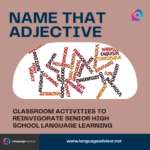Adjective Opinions: A Fun Speaking Activity for Practicing -ed and -ing Adjectives with free printable PDF worksheet
Adjective Opinions

Adjective Opinions
In English, adjectives ending in -ed and -ing play an important role in expressing emotions and describing experiences. The “Adjective Opinions” activity is a fun speaking exercise where students practice using these adjectives to share opinions and feelings about various topics. It’s a great way to reinforce understanding and fluency in using both forms of adjectives while encouraging conversation.
This activity is simple to prepare and works for learners of different ages and proficiency levels. Best of all, you can download a free worksheet to help you set up the game!
How to Play Adjective Opinions
Preparation
Before the lesson, prepare one copy of the worksheet for each pair of students. The worksheet should include sentences with missing adjectives where students can fill in the blanks. You’ll also need to explain the difference between adjectives ending in -ed and -ing.
- Adjectives ending in -ed describe how people feel (e.g., bored, excited, interested).
- Adjectives ending in -ing describe the thing or situation causing the feeling (e.g., boring, exciting, interesting).
Provide students with several examples to clarify the difference.
Step-by-Step Procedure
1️⃣ Explain the Adjectives
Start by explaining the difference between adjectives ending in -ed and -ing. For example, explain that “bored” describes how a person feels, while “boring” describes the thing causing that feeling.
2️⃣ Divide the Class into Pairs
Split the students into pairs, giving one student in each pair the “A” worksheet and the other the “B” worksheet.
3️⃣ Complete the Sentences
Have each student fill in the sentences on their worksheet using true information about themselves. Each sentence will require an adjective with either the -ed or -ing ending. For example:
- “I was really _______ (bored/boring) during the history class.”
- “The movie we watched was _______ (excited/exciting).”
4️⃣ Sharing and Discussing
Once the students have finished writing, they take turns reading their sentences to their partner and explaining why they chose those adjectives. They should try to keep the conversation going by asking follow-up questions based on their partner’s answers. For instance, if one student says, “I was really bored in the history class,” the partner can ask, “What made the class so boring?”
5️⃣ Test Each Other
After the conversation phase, have students exchange worksheets. Now, instead of saying the adjective, they use the word “blank” in place of the adjective. The partner then completes the sentence and fills in the missing adjective. For example:
- Student A says: “I was really _______ during the history class.”
- Student B responds: “You were really bored.”
6️⃣ Keep the Conversation Going
Encourage students to ask more questions based on their partner’s answers. This will help them practice using both -ed and -ing adjectives in a natural conversation.
Variations and Extensions
🔹 Group Discussions – Instead of pairs, have small groups of students share their opinions with each other. This gives more students the opportunity to speak and practice.
🔹 Adjective Lists – Provide a list of -ed and -ing adjectives for students to choose from to help them get started.
🔹 Role Play – Turn the activity into a role play by asking students to imagine different situations and then express their feelings about them.
Why Use Adjective Opinions in Your Classroom?
✅ Reinforces Grammar – Students practice the correct use of adjectives ending in -ed and -ing.
✅ Boosts Speaking Skills – Encourages students to speak and explain their answers in full sentences.
✅ Promotes Conversation – Helps students engage in meaningful discussions and practice asking follow-up questions.
✅ Flexible for All Levels – This activity can be adapted for beginners or advanced learners by adjusting the complexity of the sentences.
✅ Fun and Interactive – The activity is a great way to keep students engaged while learning grammar.
Free Printable Worksheet
To make this activity even easier, we’ve provided a free, downloadable worksheet that you can use in class. Simply print it out, and you’re ready to go!
Final Thoughts
The “Adjective Opinions” activity is a fun and effective way for students to practice using -ed and -ing adjectives in conversation. By discussing their own experiences and feelings, students will not only reinforce their grammar knowledge but also gain more confidence in speaking. It’s a great addition to any lesson on adjectives, and it can be adapted to suit a variety of lesson plans.
Give it a try in your next class and watch your students improve their speaking skills while having fun! 🎉✨

📩 Want more free ESL grammar lesson? Share this post with other teachers and let us know how it worked in your classroom!
💬 What other grammar topics would you like? Drop your ideas in the comments!

DOWNLOAD THE PDF FOR FREE

Also check out these English grammar resources












